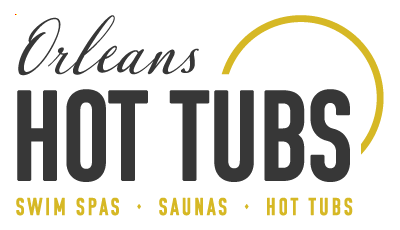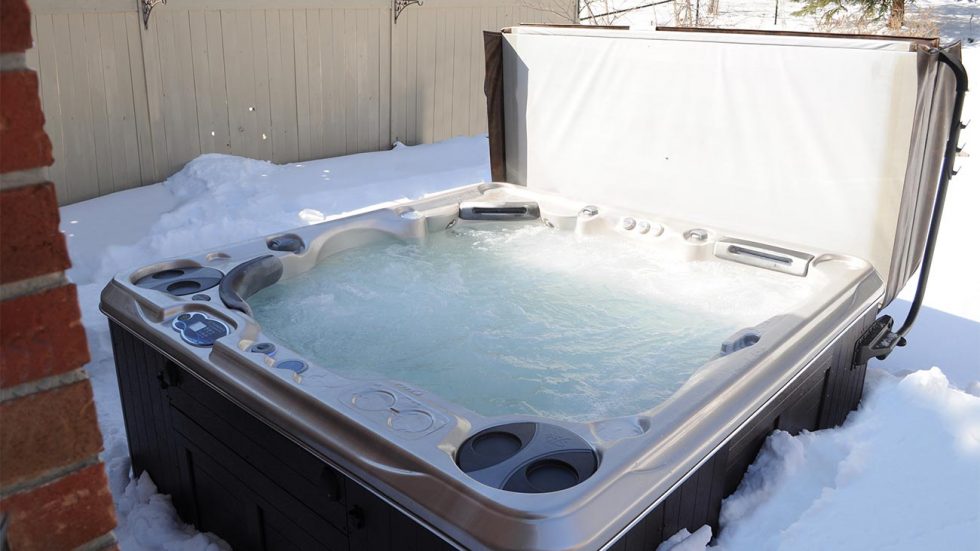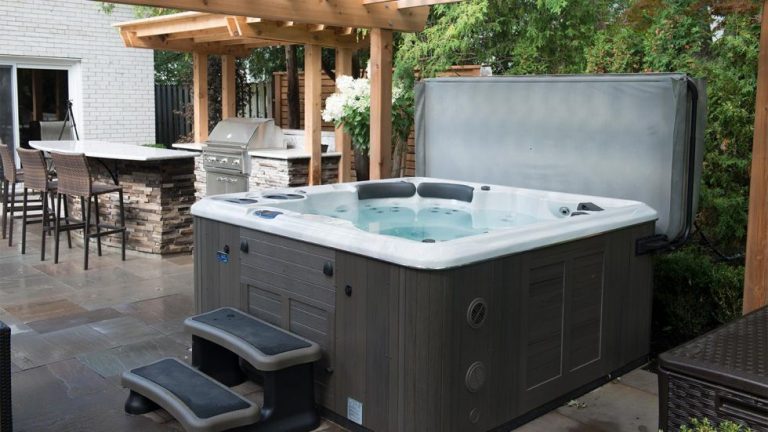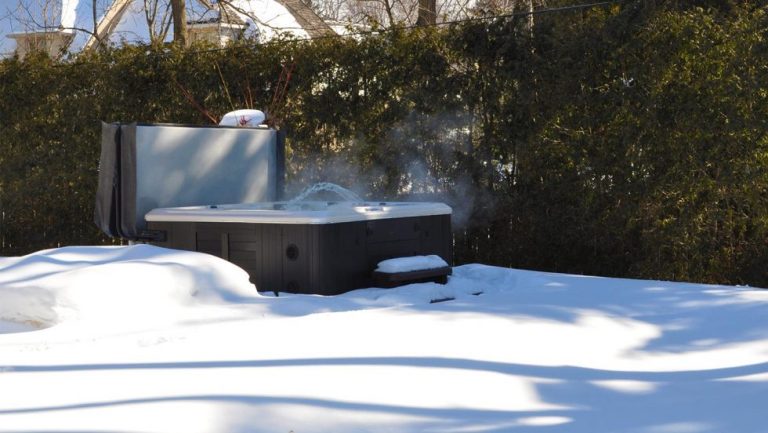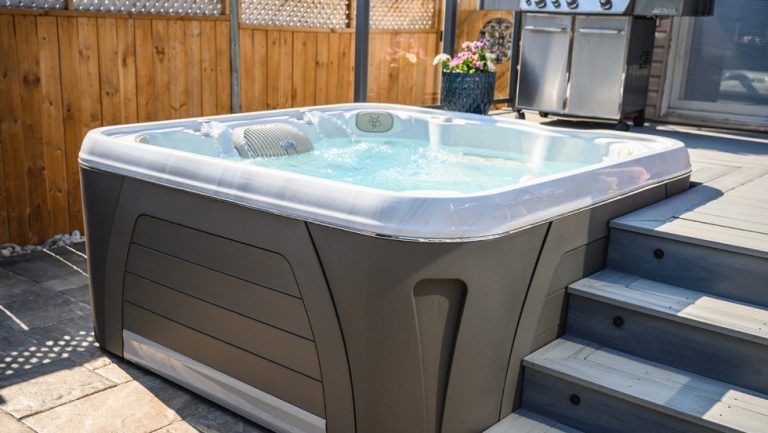With hydro rates continuing to increase, one thing on the mind of many hot tub owners is how to reduce their hot tub’s energy costs. While new hot tubs are becoming more energy efficient over time, older hot tubs can still end up costing quite a bit to maintain. Even new, energy efficient hot tubs can end up costing more than they need to if they’re not properly set up and maintained. In today’s article, we will provide tips that will help any hot tub owner reduce their hot tub’s energy consumption.
There are 2 main ways to reduce your hot tub’s energy consumption.
- Increase or improve the insulation in the hot tub.
- Increase the efficiency of the hot tub’s equipment (pumps, heater, etc.)
DECREASING A HOT TUB’S ENERGY COSTS – ADDING / IMPROVING INSULATION
ADDING MORE INSULATION
The simplest way to improve your hot tub’s energy efficiency is to increase the amount of insulation that it has.
Most new hot tubs are well insulated. Many, however, are missing something that can greatly help their energy efficiency; insulation that is installed on the cabinet of the hot tub. Adding insulation around the cabinet of your hot tub has two major benefits:
- It traps the waste heat created by the pumps and heater; increasing the hot tub’s energy efficiency.
- It helps to protect the pumps, heater and other equipment from the cold in the event that the hot tub loses power in the middle of winter.
While adding insulation to the cabinet of the hot tub will increase the energy efficiency of the hot tub, don’t completely stuff the hot tub with insulation. Keep in mind that the pumps need air to cool themselves, if they don’t get enough fresh air they will eventually overheat. Leave any cabinet vents unobstructed and remove the added insulation in the summer to avoid potential damage to your hot tub equipment.
Don’t want to add the insulation yourself? Afraid that you might damage your pumps? Hydropool hot tubs have you covered! Hydropool insulate both the shell and the cabinet of all of their hot tubs while also including variable vents. These vents allow you to add fresh air in the summer to protect your pumps and seal them up in the winter for maximum energy efficiency.
REPLACING YOUR OLD HOT TUB COVER
Another way to increase your hot tub’s energy efficiency is to replace your old, worn out hot tub cover. Worn out hot tub covers are often the largest source of heat loss for hot tubs. Much like hot tubs themselves, hot tub covers utilize foam to provide insulation. Over time, the cover will begin to take on water, which greatly reduces it’s energy efficiency.
Foam insulation works by trapping heat in the air bubbles that make up the insulation. While air is a great insulator, water is not. If the foam gets wet and those air bubbles fill with water, the insulation loses most of its effectiveness. For this reason, a waterlogged hot tub cover can easily cost you hundreds of dollars per year in added energy costs.
Along with replacing your hot tub cover, you can also buy insulating thermal blankets that sit on the top of the water. These help in two ways:
- Adding more insulation to the hot tub.
- Slowing evaporation. A significant amount of the overall heat loss in well insulated hot tubs comes from evaporation.
KEEP YOUR COVER CLIPS FASTENED
One easy way to increase the energy efficiency of any hot tub is simply to make sure that your hot tub cover clips are fastened. Unfastened hot tub covers can be slightly lifted by wind or, if your air controls are left open, from positive air pressure building up under the cover. This allows heat to escape and greatly increases evaporation.
Fastening the cover lock clips keeps your hot tub cover firmly closed. A closed cover creates a seal on the outer edge of the hot tub shell, greatly reducing the amount of heat and moisture that can escape, and greatly increasing your hot tub’s energy efficiency.
If your cover lock clips are broken, replacements clips can be purchased from any hot tub retailer.
FIXING LEAKS
Just like the rigid foam insulation found in hot tub covers, the enemy of the spray foam insulation used to insulate hot tub plumbing is water. This is why it is so important to properly fix leaks in your hot tub, no matter how small.
If you notice a leak in your hot tub be sure to have it fixed as soon as possible. Over time even minor leaks can cause the majority of your hot tub’s insulation to become waterlogged, greatly reducing its energy efficiency. Not only that, every time you top up the hot tub water you’re replacing water you’ve already paid to heat with cold water that will now have to be heated.
When fixing leaks, it is also important to remove any waterlogged insulation and replace it with new insulation. Waterlogged foam insulation is almost impossible to dry out. Leaving it in can cost you $100s or even $1000s of dollars over the lifespan of the hot tub.
DECREASING A HOT TUB’S ENERGY COSTS – INCREASING EFFICIENCY
Along with adding or improving your hot tub’s insulation, another way to decrease your hot tub’s running costs is to improve the efficiency of it’s “equipment”, in this case meaning it’s pumps and heater. You can do this by:
Programming your Filtration Cycles
One of the easiest ways to reduce the energy costs of your hot tub is to program it’s filtration cycles.
All hot tubs need to filter their water to get rid of contaminants and keep the water clear and safe to use. To do this, hot tubs are programmed to turn on one of their pumps to cycle the water through the hot tub filter for a set amount of time every day. While important, this process accounts for a significant part of the monthly hydro cost of a hot tub.
Fortunately, most modern hot tubs allow for at least some degree of control over their filtration cycles. To figure out how to make changes to your hot tub’s filtration cycles, consult your hot tub retailer or your hot tub owner’s manual.
Once you know how to change your filtration cycles, program them to run during off-peak or mid-peak hours to spend less without sacrificing water quality. To maximize your savings some hot tubs, like Hydropool’s Self Cleaning hot tubs, even allow you to program different run times on different days. Use this feature to run your hot tub less on days where you don’t typically use the hot tub.
Using Economy Mode
If you’re going on vacation, or just won’t be using it for a while, check to see if your hot tub has an “economy mode”. In standard filtration mode, if the water temperature in a hot tub drops 2 degrees below it’s set temperature, the hot tub will turn on and heat the water back to set temperature. Economy mode stops this process, only allowing the heater to run during your scheduled filtration times. This saves you money by reducing the amount of time that the pumps and heater are running.
The downside of economy mode is temperature fluctuation. Since the heater isn’t running for long periods of time, the water temperature can vary quite a bit. This is less than ideal if you are planning on using the hot tub. For this reason, it’s best to only run economy mode when you’re not going to be home for 3 or more days. You should also set the hot tub back to standard mode at least 6-8 hours before you plan on using it to ensure that it is at your desired temperature.
Some hot tubs, like Hydropool’s Self-Cleaning hot tubs, have preset programs that can automatically switch between economy mode and standard mode. These programs are useful if you’re gone for a few days but want to use your hot tub when you get back.
Lowering your Water Temperature
The easiest way to spend less to run your hot tub is simply to lower the temperature of the water. Depending on the temperature of the outside air, lowering the temperature of your hot tub water by 1 only degree Fahrenheit can lower your energy bill by up 10-15%!
This does not mean that you should be constantly changing your hot tub temperature though. Often times, the cost of heating the water back up to temperature can be more than what you saved by lowering the temperature in the first place. Instead, try simply setting your hot tub 1-2 degrees cooler than you normally would.
WRAPPING UP
While buying a new hot tub is still the best way to ensure you’re spending as little as possible to run your hot tub, it’s not always practical to do so. Even if you have a brand new hot tub, there are still ways that you can reduce your energy costs. Small things like lowering your temperature of the water slightly or reprogramming your hot tub’s filtration can make a large difference on your energy bill.
